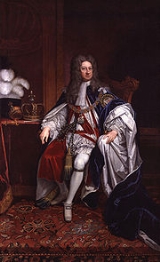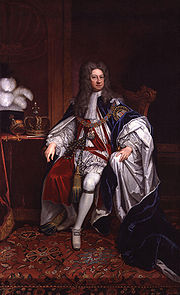
State Crown of George I
Encyclopedia
The State Crown of George I was the state crown
manufactured for King George I of Great Britain
.
When George I
became King of Great Britain
and King of Ireland
in 1714 it was decided to replace the previous state crown (i.e., the crown worn to open parliament), created for King Charles II
in 1661, by a new crown, as the old one was judged "weak" and in a poor state of repair. Much of the ornamentation was transferred to the new crown. As with precedent, however, it was set not with precious gems but with decorated stones and glass.
 The crown itself consisted of four half-arches
The crown itself consisted of four half-arches
on a golden band, with the aquamarine monde
and cross that had been added to King Charles's state crown in 1685. On top of it stood the cross
.
In 1727 the glass and stones were removed and replaced with hired diamonds, valued at £109,200, and in this newly set version the crown was used for the coronation of King George II
, though with one difference. The arches, which, had curved downwards at the centre of the crown, were pulled upwards, leading to a flat top on the crown surmounted by the aquamarine monde and cross.
The crown was used subsequently for the coronations of Kings George III
and William IV
. In 1820, because it was seen as being a "very poor affair", further work was carried out on the crown, including the replacement of the aquamarine monde, which on inspection was revealed to be merely blue-green glass. The crown was present in this state at the coronation of King George IV
who was, however, crowned with a new diamond crown of his own. In its restored state George I's crown was used for William IV's coronation in 1831.
This was to be the last occasion on which it was worn by a monarch. It was carried before Queen Victoria
at the State Opening Parliament early in her reign (on one occasion being dropped and flattened), but before her coronation Victoria replaced George I's state crown by a new Imperial State Crown, re-using many of its precious stones. The empty and abandoned frame of the 1714 crown, along with the frames of the coronation crowns of George IV and Adelaide of Saxe-Meiningen
(the wife of William IV), were apparently sold to the Crown Jewellers.
The empty frames of all these crowns were given to Elizabeth II in 1995 and are now on display in the Martin Tower in the Tower of London.
State crown
A state crown is the working crown worn by a monarch on recurring state occasions such as State Openings of Parliament, as opposed to the coronation crown with which they would be formally crowned....
manufactured for King George I of Great Britain
George I of Great Britain
George I was King of Great Britain and Ireland from 1 August 1714 until his death, and ruler of the Duchy and Electorate of Brunswick-Lüneburg in the Holy Roman Empire from 1698....
.
When George I
George I of Great Britain
George I was King of Great Britain and Ireland from 1 August 1714 until his death, and ruler of the Duchy and Electorate of Brunswick-Lüneburg in the Holy Roman Empire from 1698....
became King of Great Britain
Kingdom of Great Britain
The former Kingdom of Great Britain, sometimes described as the 'United Kingdom of Great Britain', That the Two Kingdoms of Scotland and England, shall upon the 1st May next ensuing the date hereof, and forever after, be United into One Kingdom by the Name of GREAT BRITAIN. was a sovereign...
and King of Ireland
King of Ireland
A monarchical polity has existed in Ireland during three periods of its history, finally ending in 1801. The designation King of Ireland and Queen of Ireland was used during these periods...
in 1714 it was decided to replace the previous state crown (i.e., the crown worn to open parliament), created for King Charles II
Charles II of England
Charles II was monarch of the three kingdoms of England, Scotland, and Ireland.Charles II's father, King Charles I, was executed at Whitehall on 30 January 1649, at the climax of the English Civil War...
in 1661, by a new crown, as the old one was judged "weak" and in a poor state of repair. Much of the ornamentation was transferred to the new crown. As with precedent, however, it was set not with precious gems but with decorated stones and glass.

Half-arch (crown)
A half-arch is the piece of gold, silver or platinum, usually decorated with jewels, that links the circlet of a hoop crown to the globe at the top of the crown.-British tradition of 4 half-arches:...
on a golden band, with the aquamarine monde
Monde (crown)
A monde is a ball-like object located near the top of a crown. It is the point at which a crown's half arches meet. It is usually topped off either with a national or religious symbol, for example a cross in Christian countries....
and cross that had been added to King Charles's state crown in 1685. On top of it stood the cross
Cross (crown)
A cross is the decoration located at the highest level of a crown on top of the monde. Its usage traditionally symbolised the Christian nature of the monarchy of that country, though not all crowns even in monarchies associated with Christianity used a cross as its top decoration, with some French...
.
In 1727 the glass and stones were removed and replaced with hired diamonds, valued at £109,200, and in this newly set version the crown was used for the coronation of King George II
George II of Great Britain
George II was King of Great Britain and Ireland, Duke of Brunswick-Lüneburg and Archtreasurer and Prince-elector of the Holy Roman Empire from 11 June 1727 until his death.George was the last British monarch born outside Great Britain. He was born and brought up in Northern Germany...
, though with one difference. The arches, which, had curved downwards at the centre of the crown, were pulled upwards, leading to a flat top on the crown surmounted by the aquamarine monde and cross.
The crown was used subsequently for the coronations of Kings George III
George III of the United Kingdom
George III was King of Great Britain and King of Ireland from 25 October 1760 until the union of these two countries on 1 January 1801, after which he was King of the United Kingdom of Great Britain and Ireland until his death...
and William IV
William IV of the United Kingdom
William IV was King of the United Kingdom of Great Britain and Ireland and of Hanover from 26 June 1830 until his death...
. In 1820, because it was seen as being a "very poor affair", further work was carried out on the crown, including the replacement of the aquamarine monde, which on inspection was revealed to be merely blue-green glass. The crown was present in this state at the coronation of King George IV
George IV of the United Kingdom
George IV was the King of the United Kingdom of Great Britain and Ireland and also of Hanover from the death of his father, George III, on 29 January 1820 until his own death ten years later...
who was, however, crowned with a new diamond crown of his own. In its restored state George I's crown was used for William IV's coronation in 1831.
This was to be the last occasion on which it was worn by a monarch. It was carried before Queen Victoria
Victoria of the United Kingdom
Victoria was the monarch of the United Kingdom of Great Britain and Ireland from 20 June 1837 until her death. From 1 May 1876, she used the additional title of Empress of India....
at the State Opening Parliament early in her reign (on one occasion being dropped and flattened), but before her coronation Victoria replaced George I's state crown by a new Imperial State Crown, re-using many of its precious stones. The empty and abandoned frame of the 1714 crown, along with the frames of the coronation crowns of George IV and Adelaide of Saxe-Meiningen
Adelaide of Saxe-Meiningen
Princess Adelaide of Saxe-Meiningen was the queen consort of the United Kingdom and of Hanover as spouse of William IV of the United Kingdom. Adelaide, the capital city of South Australia, is named after her.-Early life:Adelaide was born on 13 August 1792 at Meiningen, Thuringia, Germany...
(the wife of William IV), were apparently sold to the Crown Jewellers.
The empty frames of all these crowns were given to Elizabeth II in 1995 and are now on display in the Martin Tower in the Tower of London.

